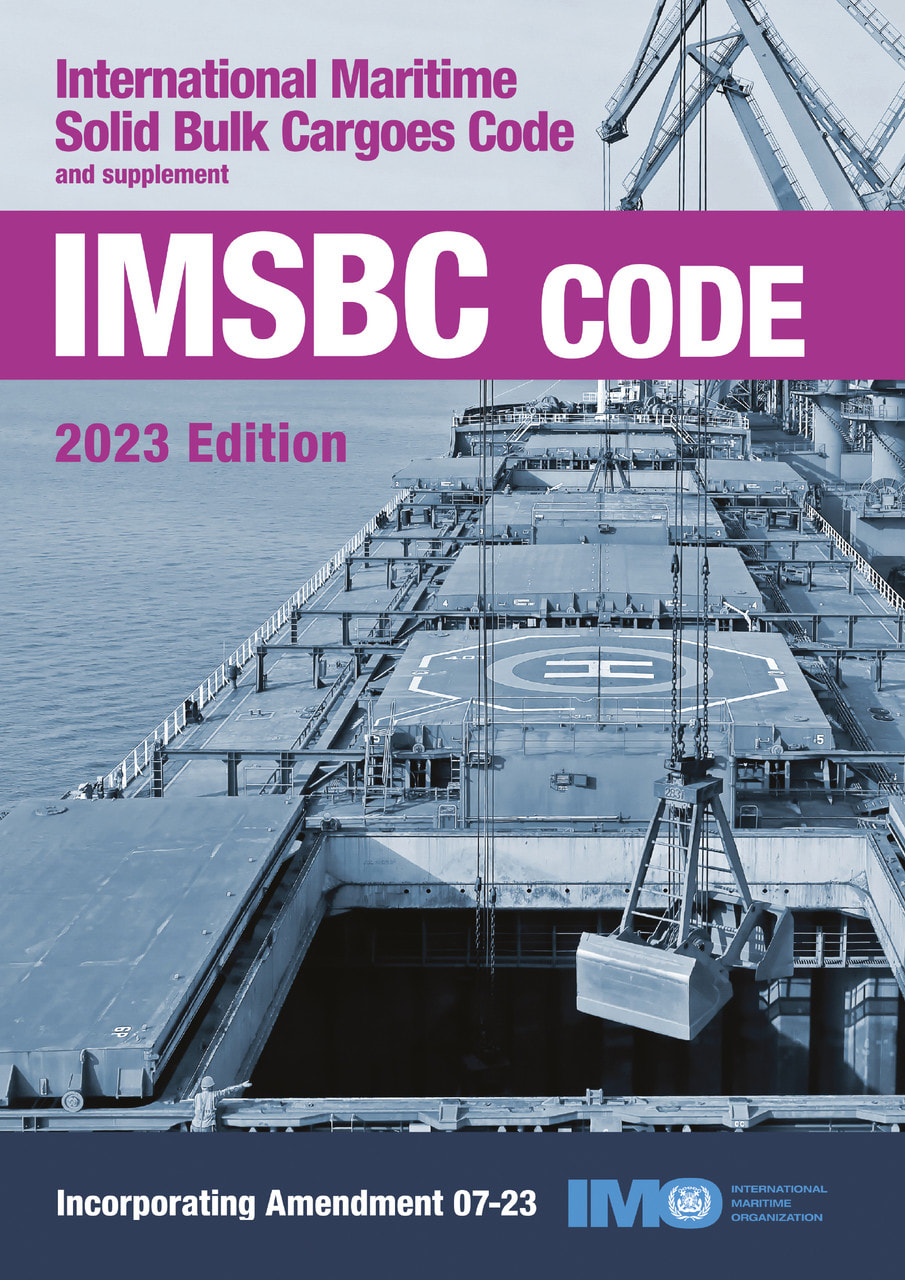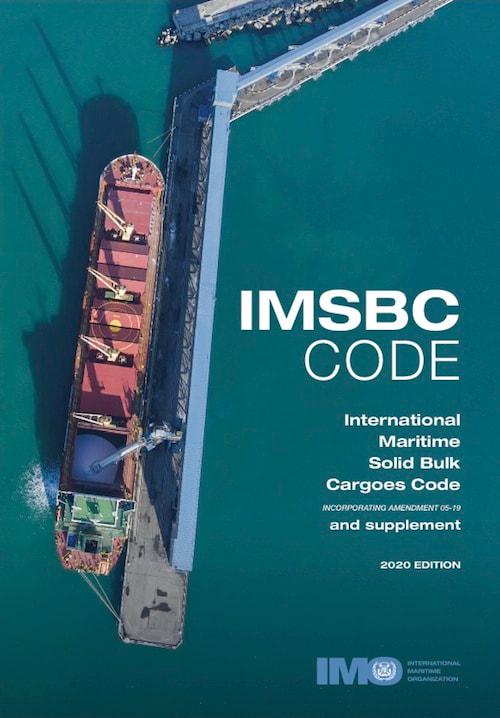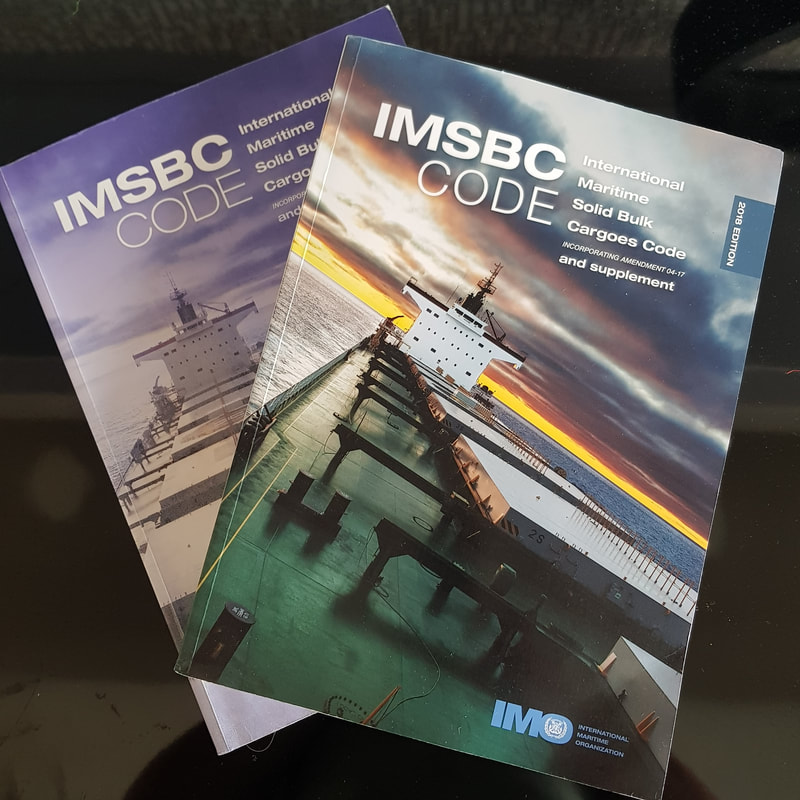Other notable updates to the IMSBC Code include the following:
0 Comments
AMSA Exemption Relating to Corrosive Properties of Solid Bulk Cargoes (Updated December 2022)
The Australian Maritime Safety Authority (AMSA) has been working with industry on issues identified with the repeatability and reliability of the modified C.1 test prescribed by section 9.2.3.7.3 of the IMSBC Code[1]. A refined Materials Hazardous only in Bulk (MHB) corrosivity (CR) test has been developed, which specifies testing of representative cargo samples at conditions representing their as-shipped properties. Amendments to be included in the 06-21 amendments to the IMSBC Code were finalised and agreed upon during CCC 5 in September 2018. These were sent to the Maritime Safety Committee (MSC) in December 2018 for that committee to issue an MSC circular. Until that circular can be formally published, AMSA has previously issued five exemptions relating to the corrosivity of solid bulk cargoes, the most recent being EX 5739 (issued 4 February 2019 and valid until 31 December 2022). Due to the global pandemic, the finalisation of the 06-21 amendments to the IMSBC Code was delayed. The Maritime Safety Committee, at its 105th session, adopted the 06-21 amendments that will come into mandatory effect on 1 December 2023 and also approved a revised circular MSC.1/Circ.1600/Rev.1 Guidance for Conducting the Refined MHB (CR) Test that reflects those amendments. AMSA has therefore issued an Exemption 6343, valid until 30 November 2023, to allow shippers to use the revised circular until the 06-21 amendments to the IMSBC Code come into mandatory effect. A shipper can use EX 6343 for any solid bulk cargo; hence it replaces all previously issued exemptions relating to the corrosivity of solid bulk cargoes (i.e. EX 5450, EX 5451, EX 5717, EX 5718 and EX 5739), regardless of the date of validity indicated on those certificates. AMSA Approval for MHB categorisation related to self-heating properties of coal (Updated December 2022) AMSA has been working with industry concerning issues identified with the repeatability and reliability of the N.4 test prescribed by section 9.2.3.3 of the IMSBC code to determine the self-heating properties of coal. While the research continues, they have issued Approval 8024, valid from 14 December 2022, which replaces the previously issued certificate of approval AP5620. This exemption permits the approval of coal, meeting certain criteria, to be MHB on the condition that extra precautions are taken. A copy of approval 8024 should be made available to Masters of vessels before loading if it is relied upon. Exemptions and approvals for the handling, transport, and categorising certain cargoes can be found here Want more information? For further information on these exemptions or approvals, or any other maritime transport compliance query please contact Davoren Environmental [email protected] [1] International Maritime Solid Bulk Cargoes Code. Incorporating Amendment 05-19 and Supplement, 2020 Edition.
A refined Materials Hazardous only in Bulk (MHB) corrosivity (CR) test has been developed which prescribes testing of representative samples of the cargo at conditions representing their as-shipped properties. The International Maritime Organization (IMO) formally published this interim guidance in January 2019 MSC.1/Circ.1600 Interim Guidance for Conducting the Refined MHB (CR) Corrosivity Test. AMSA have recently issued exemption EX5739 which allows shippers to use this guidance in the circular until 31 December 2022 when it is agreed and finalised in the 06-21 amendments to the IMSBC Code, considering the mandatory entry into force would be 1 January 2023.
AMSA have previously issued two exemptions also relating to corrosivity:
Want more information? For further information on this exemption, or conducting the refined MHB (CR) corrosivity test, or for any other maritime transport compliance query please contact Davoren Environmental [email protected] The Australian Maritime Safety Authority (AMSA) have been working with industry on issues identified with the repeatability and reliability of the modified C.1 test prescribed by section 9.2.3.7.3 of the International Maritime Solid Bulk Cargoes Code (IMSBC Code[1]). AMSA have previously issued two exemptions, namely EX5450 (issued 19 December 2016) and EX5451 (issued 21 December 2016) in respect of assessing the corrosive properties of solid bulk cargoes. Both of these exemptions were valid until the 04-17 amendment to the IMSBC Code came into mandatory effect from 1 January 2019. Issues relating to use of the C.1 test for assessing the corrosive properties of Solid Bulk Cargoes have been progressed at meetings of the sub-committee for the Carriage of Cargoes and Containers (CCC) at the International Maritime Organization (IMO). A refined Materials Hazardous only in Bulk (MHB) corrosivity (CR) test has been developed which prescribes testing of representative samples of the cargo at conditions representing their as-shipped properties. Amendments to be included in the 06-21 amendments to the IMSBC Code were finalised and agreed during CCC 5 in September 2018. These were sent to the Maritime Safety Committee (MSC) in December 2018 for that committee to issue an MSC circular. Until that circular can be formally published, allowing AMSA to permit use of it, and to allow shippers a period to transition to the contents of the circular once it is formally published, AMSA has issued two exemptions valid until the end of June 2019, to replace those previously issued as detailed below:
Want more information?For further information on these exemptions, or conducting the refined MHB (CR) corrosivity test, or for any other maritime transport compliance query please contact Davoren Environmental
[email protected] [1] International Maritime Solid Bulk Cargoes Code. Incorporating Amendment 04-17 and Supplement, 2018 Edition. The IMSBC Code[1] establishes international provisions for the safe loading, trimming, carriage and discharge of solid bulk cargoes when transported by sea, ensuring compliance with the provisions of the SOLAS Convention and identifies the risks associated with such cargoes with the aim of taking measures to minimise and control them. One of the risks identified is the risk associated with liquefaction of certain cargoes. Such cargoes are identified as Group A cargoes in the IMSBC Code. Group A Cargoes are defined as cargoes which may liquefy if shipped at a moisture content in excess of their transportable moisture limit (TML). The TML of a cargo means the maximum moisture content of the cargo which is considered safe for carriage in ships. In accordance with paragraph 4.3.3 of the IMSBC Code, when a cargo which may liquefy is carried, procedures for sampling, testing and controlling the moisture content to ensure the moisture content is less than the TML when it is on board the ship, shall be established by the shipper. A Moisture Management Plan which verifies and documents these procedures should therefore be prepared by the shipper in line with established guidelines[2]. This plan should be provided well in advance of shipment to the Competent Authority (CA), at the port of loading. The CA will review the procedures and once verified that they are in accordance with the relevant guidelines will issue an approval for transport of that cargo. This approval is then provided to the Master of the vessel intended to be loaded. In the latest edition of the IMSBC Code, there are some notable amendments to existing schedules which relate specifically to their Group A designation:
*Shippers of Bauxite should also note that whilst this cargo is listed as a Group C cargo in the IMSBC Code (2016 and 2018 Editions), recent work conducted by the industry Global Bauxite Working Group (GBWG) in conjunction with CAs indicate that Bauxite represents a risk caused by moisture. As such, some Bauxite cargoes should be treated as Group A cargoes. Pending adoption of changes into the IMSBC Code, the Australian Maritime Safety Authority (AMSA) have issued approval AP5456 to allow the test and schedules adopted by CCC-4 to be applied to Bauxite when shipped from Australia in solid form in bulk. These changes will be included in a future amendment to the IMSBC Code, which is expected to enter into force on 1 January 2021. Until such time, any bauxite cargoes should be classified as Group A or Group C and are to be carried in accordance with the draft procedures specified in AP5456 and with subsection 1.3 of the IMSBC Code. Davoren Environmental have significant experience in preparing Moisture Management Plans in accordance with IMO guidelines for shipment approval. Want More Information? For further information on how we can assist your company with preparation of Moisture Management Plans or for any other transport compliance requirements please contact Davoren Environmental [email protected] [1] The IMSBC Code & Supplement, 2018 Edition was released in March 2018. The latest edition incorporates amendment 04-17 (Resolution MSC.426(98)), which may be applied from 1 January 2018 on a voluntary basis, anticipating its envisaged official entry into force on 1 January 2019.
[2] Guidelines for developing and approving procedures for sampling, testing and controlling the moisture content for solid bulk cargoes which may liquefy. 15 June 2015. MSC.1/Circ.1454/Rev.1. International Maritime Organization. [3] Coal shall be classified as Group A and B unless classified as Group B only by a test determined by the appropriate authority or where it has particle size distribution stated in 2018 Code schedule.
Other notable changes to the IMSBC Code include:
Want more information?For further information on how we can assist your company with transport compliance requirements for solid bulk cargoes please contact Davoren Environmental [email protected]
Many materials produced or used in the mining and minerals processing industry are classified as hazardous according to the Globally Harmonized Classification System (GHS). The correct classification of these materials is therefore imperative to properly manage any potential health and environmental risks and ensure compliance with relevant legislative requirements[1], [2].
Davoren Environmental have significant experience working with the mining industry to conduct hazard assessments on a wide range of materials for classification against relevant transport codes[3]. Some of the materials assessed include:
Our aim is to make the hazard assessment and classification process as simple and tailored as possible by: 1. Consulting with the client to: a. Fully understand the material’s physical/chemical characteristics to identify the relevant hazards that apply, and consequently the applicable tests that need to be conducted; and b. Confirming how this material will be transported to identify relevant legislation to be addressed. 2. Coordinate and manage this testing directly with laboratory; 3. Compile a comprehensive classification report based on results of 1 and 2 above which will clearly detail the hazard assessment and classification of the material against applicable transport regulations. Want More Information? For further information on how we can assist your company with transport compliance requirements please contact Davoren Environmental [email protected] [1] ICMM, 2014. Hazard Assessment of Ores and Concentrates for Marine Transport. [2] Australian Government, 2016. Hazardous Material Management: Leading Practice Sustainable Development Program for the Mining Industry. [3] Australian Code for the Transport of Dangerous Goods by Road and Rail (ADG) in Australia; International Maritime Dangerous Goods (IMDG) Code for maritime transport of packaged dangerous goods, including substances, mixtures and articles; and the International Maritime Solid Bulk Cargoes (IMSBC) Code and International Convention for the Prevention of Pollution from Ships (MARPOL Annex V) for shipment of solid bulk cargoes. The Australian Maritime Safety Authority (AMSA) has issued two recent exemptions in respect of assessing the corrosive properties of solid bulk cargoes. EX5450AMSA issued EX5450 on the 19th of December 2016, which allows shippers of the following solid bulk cargoes
What does the exemption mean? The exemption means that producers and shippers of the above listed cargoes may use the standard DIN 50 929 Part 3[1] as an alternative method to evaluate localised corrosion of these cargoes. The rate of uniform corrosion shall still be evaluated using the UN Manual of Tests and Criteria, part III, Section 37 Test C.1 and as prescribed in Section 9.2.3.7.3 in the IMSBC Code, inclusive of the 03-15 amendments. This exemption replaces previously issued EX5389 which is now revoked and was specifically for IRON ORE and IRON ORE FINES only. EX5451EX5451 was issued on the 21st of December 2016 and allows shippers of the following solid bulk cargoes
What are the modifications? The main change is the use of steel coupons only which are considered to be more representative of ships’ structures. Other notable amendments in the modified test are the sealing of the test container to prevent air exchange, a specified air to solids ratio and more prescriptive guidance on sample introduction and compaction within the test container. Want more information?For further information for assessment of localised corrosion according to DIN 50 929 Part 3 (EX5450) or the modified Test C.1 (EX5451) or for any other maritime transport compliance query please contact Davoren Environmental [email protected].
[1] Corrosion of metals; probability of corrosion of metallic materials when subject to corrosion from the outside; buried and underwater pipelines and structural components. September 1985. The CodeThe principal aim of the IMSBC Code is to enable the safe stowage and shipment of solid bulk cargoes by providing information on the dangers associated with the shipment of certain types of solid bulk cargoes and instructions on the practices and procedures to be followed when planning to ship solid bulk cargoes. The IMSBC Code is subject to updates every two years to keep pace with the nature and variety of solid bulk cargoes presented for shipment, and developments in understanding regarding the safest ways to carry established solid bulk cargoes. Recent ChangesIn June 2015, the IMO’s Maritime Safety Committee (MSC) adopted the most recent amendments Resolution MSC.393 (95) specifying forthcoming changes to the IMSBC Code. Amongst the adopted amendments (03-15) are included specific changes to Section 9 of the Code Material Hazardous only in Bulk (MHB). According to the adopted amendments, where a cargo is found to meet one or more of the chemical hazards for MHB designation as defined below, a notational reference for each hazard must be included in the “Class" cell. A summary of the notational references to be used is presented below: Summary of Notational References for Classification of Relevant MHB Hazards
Resolution MSC.393(95), incorporating amendment 03-15, may be applied from the 1st of January 2016 on a voluntary basis, anticipating its envisaged official entry into force on the 1st of January 2017. * Where deviations from the chemical hazards described in 9.2.3.2 to 9.2.3.7 of IMSBC Code have been determined (Other hazards (OH)), they shall be properly recorded with justifications. Other hazards are to be included in the section for “hazard” in the individual schedule. Want More Information?For further information on how to classify your solid bulk cargo to address the new MHB designation requirements or for any other maritime transport compliance query please contact Davoren Environmental [email protected]
|
Archives
January 2020
Categories
All
|
Services |
Company |
© COPYRIGHT 2016. ALL RIGHTS RESERVED.
|




 RSS Feed
RSS Feed